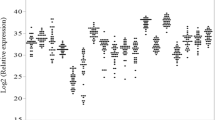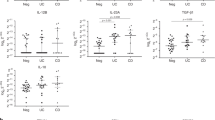Abstract
Background
T helper (Th) and regulatory T (Treg) cell-related cytokines are implicated in inflammatory bowel diseases, including ulcerative colitis (UC). While these cytokines are generally upregulated in inflamed mucosae, the key cytokine profile explaining disease severity has not been determined.
Methods
The Rachmilewitz endoscopic index (REI) was assessed in 61 UC patients undergoing colonoscopy. Biopsies obtained from inflamed (REI 3–12) and noninflamed (REI 0–2) areas were analyzed by quantitative PCR for expression of mRNAs encoding cytokines and transcription factors related to Th1 (TNF-α, IFN-γ, IL-12p35, IL-12p40, and T-bet), Th2 (IL-4, IL-13, IL-33, and GATA3), Th17 (IL-17A, IL-17F, IL-21, IL-22, IL-23p19, IL-6, and RORC), Th9 (IL-9, IRF4, and PU.1), and Treg (TGF-β and Foxp3). Expression patterns associated with higher REI were determined by univariate and multivariate analyses.
Results
Despite general upregulation, none of these mRNAs showed univariate correlation with REI in inflamed samples. Multiple regression analysis, however, found that joint expression of IL-17A, IL-17F, IL-21, RORC, and TGF-β was significantly predictive of REI (P < 0.0002, R2 = 0.380), with major individual contributions by IL-17A (P < 0.0001) and IL-17F (P < 0.0001), which were associated with increased and decreased REI, respectively. Partial correlation analysis, validating this model, indicated differences between IL-17A and IL-17F in correlating with other targets. The IL-17A/IL-17F ratio showed a significant correlation with REI (r = 0.5124, P < 0.0001), whereas no other mRNAs were essentially predictive of REI.
Conclusions
Mucosal IL-17A/IL-17F ratio significantly correlates with endoscopic score in UC patients, accompanied by their disparate interactions with other Th/Treg-related genes.




Similar content being viewed by others
References
Nikolaus S, Schreiber S. Diagnostics of inflammatory bowel disease. Gastroenterology. 2007;133:1670–89.
Xavier RJ, Podolsky DK. Unravelling the pathogenesis of inflammatory bowel disease. Nature. 2007;448:427–34.
Strober W, Fuss IJ. Proinflammatory cytokines in the pathogenesis of inflammatory bowel diseases. Gastroenterology. 2011;140:1756–67.
Fuss IJ, Neurath M, Boirivant M, et al. Disparate CD4 + lamina propria (LP) lymphokine secretion profiles in inflammatory bowel disease. Crohn’s disease LP cells manifest increased secretion of IFN-gamma, whereas ulcerative colitis LP cells manifest increased secretion of IL-5. J Immunol. 1996;157:1261–70.
Fuss IJ, Heller F, Boirivant M, et al. Nonclassical CD1d-restricted NK T cells that produce IL-13 characterize an atypical Th2 response in ulcerative colitis. J Clin Invest. 2004;113:1490–7.
Heller F, Florian P, Bojarski C, et al. Interleukin-13 is the key effector Th2 cytokine in ulcerative colitis that affects epithelial tight junctions, apoptosis, and cell restitution. Gastroenterology. 2005;129:550–64.
Kobori A, Yagi Y, Imaeda H, et al. Interleukin-33 expression is specifically enhanced in inflamed mucosa of ulcerative colitis. J Gastroenterol. 2010;45:999–1007.
Christophi GP, Rong R, Holtzapple PG, et al. Immune markers and differential signaling networks in ulcerative colitis and Crohn’s disease. Inflamm Bowel Dis. 2012;18:2342–56.
Monteleone G, Biancone L, Marasco R, et al. Interleukin 12 is expressed and actively released by Crohn’s disease intestinal lamina propria mononuclear cells. Gastroenterology. 1997;112:1169–78.
Matsuoka K, Inoue N, Sato T, et al. T-bet upregulation and subsequent interleukin 12 stimulation are essential for induction of Th1 mediated immunopathology in Crohn’s disease. Gut. 2004;53:1303–8.
Harrington LE, Hatton RD, Mangan PR, et al. Interleukin 17-producing CD4 + effector T cells develop via a lineage distinct from the T helper type 1 and 2 lineages. Nat Immunol. 2005;6:1123–32.
Park H, Li Z, Yang XO, et al. A distinct lineage of CD4 T cells regulates tissue inflammation by producing interleukin 17. Nat Immunol. 2005;6:1133–41.
Fujino S, Andoh A, Bamba S, et al. Increased expression of interleukin 17 in inflammatory bowel disease. Gut. 2003;52:65–70.
Holtta V, Klemetti P, Sipponen T, et al. IL-23/IL-17 immunity as a hall- mark of Crohn’s disease. Inflamm Bowel Dis. 2008;14:1175–84.
Kobayashi T, Okamoto S, Hisamatsu T, et al. IL23 differentially regulates the Th1/Th17 balance in ulcerative colitis and Crohn’s disease. Gut. 2008;57:1682–9.
Hölttä V, Klemetti P, Salo HM, et al. Interleukin-17 immunity in pediatric Crohn disease and ulcerative colitis. J Pediatr Gastroenterol Nutr. 2013;57:287–92.
Verma R, Verma N, Paul J. Expression of inflammatory genes in the colon of ulcerative colitis patients varies with activity both at the mRNA and protein level. Eur Cytokine Netw. 2013;24:130–8.
Öhman L, Dahlén R, Isaksson S, et al. Serum IL-17A in newly diagnosed treatment-naive patients with ulcerative colitis reflects clinical disease severity and predicts the course of disease. Inflamm Bowel Dis. 2013;19:2433–9.
Fransen K, van Sommeren S, Westra H-J, et al. Correlation of genetic risk and messenger RNA expression in a Th17/IL23 pathway analysis in inflammatory bowel disease. Inflamm Bowel Dis. 2014;20:777–82.
Bettelli E, Oukka M, Kuchroo VK. T(H)-17 cells in the circle of immunity and autoimmunity. Nat Immunol. 2007;8:345–50.
Moran EM, Mullan R, McCormick J, et al. Human rheumatoid arthritis tissue production of IL-17A drives matrix and cartilage degradation: synergy with tumour necrosis factor-alpha, Oncostatin M and response to biologic therapies. Arthritis Res. Ther. 2009;11:R113.
Nakamura K, Kitani A, Strober W. Cell contact-dependent immunosuppression by CD4(+)CD25(+) regulatory T cells is mediated by cell surface-bound transforming growth factor beta. J Exp Med. 2001;194:629–44.
Nakamura K, Kitani A, Fuss I, et al. TGF-beta 1 plays an important role in the mechanism of CD4 + CD25 + regulatory T cell activity in both humans and mice. J Immunol. 2004;172:834–42.
Asseman C, Mauze S, Leach MW, Coffman RL, Powrie F. An essential role for interleukin 10 in the function of regulatory T cells that inhibit intestinal inflammation. J Exp Med. 1999;190:995–1004.
Nalleweg N, Chiriac MT, Podstawa E, et al. IL-9 and its receptor are predominantly involved in the pathogenesis of UC. Gut. 2015;64:743–55.
Raddatz D, Bockemühl M, Ramadori G. Quantitative measurement of cytokine mRNA in inflammatory bowel disease: relation to clinical and endoscopic activity and outcome. Eur J Gastroenterol Hepatol. 2005;17:547–57.
Zahn A, Giese T, Karner M, et al. Transcript levels of different cytokines and chemokines correlate with clinical and endoscopic activity in ulcerative colitis. BMC Gastroenterol. 2009;9:13.
Tsukada Y, Nakamura T, Iimura M, Iizuka BE, Hayashi N. Cytokine profile in colonic mucosa of ulcerative colitis correlates with disease activity and response to granulocytapheresis. Am J Gastroenterol. 2002;97:2820–8.
Matsuda R, Koide T, Tokoro C, et al. Quantitive cytokine mRNA expression profiles in the colonic mucosa of patients with steroid naive ulcerative colitis during active and quiescent disease. Inflamm Bowel Dis. 2009;15:328–34.
Dziuda DM. Data mining for genomics and proteomics: analysis of gene and protein expression data, vol. 1. New york: John Wiley & Sons; 2010.
Karp LC. Heterogeneity of inflammatory bowel diseases. In: Stephan RT, editor. In: Stephan RT, Fergus S, Loren CK, editors. Inflammatory bowel disease: translating basic science into clinical practice. Hoboken: Wiley-Blackwell; 2010.
Iboshi Y, Nakamura K, Ihara E, et al. Multigene analysis unveils distinctive expression profiles of helper T-cell–related genes in the intestinal mucosa that discriminate between ulcerative colitis and Crohn’s disease. Inflamm Bowel Dis. 2014;20(6):967–77.
Rachmilewitz D. Coated mesalazine (5-aminosalicylic acid) versus sulphasalazine in the treatment of active ulcerative colitis: a randomised trial. Br Med J. 1989;298(6666):82–6.
Hirai F, Matsui T. A critical review of endoscopic indices in ulcerative colitis: inter-observer variation of the endoscopic index. Clin J Gastroenterol. 2008;1:40–5.
Hirai F, Matsui T, Aoyagi K, et al. Validity of activity indices in ulcerative colitis: comparison of clinical and endoscopic indices. Dig Endosc. 2010;22(1):39–44.
Schoepfer AM, Beglinger C, Straumann A, et al. Ulcerative colitis: correlation of the Rachmilewitz endoscopic activity index with fecal calprotectin, clinical activity, C-reactive protein, and blood leukocytes. Inflamm Bowel Dis. 2009;15(12):1851–8.
Florholmen J, Fries W. Candidate mucosal and surrogate biomarkers of inflammatory bowel disease in the era of new technology. Scand J Gastroenterol. 2011;46:1407–17.
Boland BS, Boyle DL, Sandborn WJ, et al. Validated gene expression biomarker analysis for biopsy-based clinical trials in ulcerative colitis. Aliment Pharmacol Ther. 2014;40:477–85.
Bogaert S, Laukens D, Peeters H, et al. Differential mucosal expression of Th17-related genes between the inflamed colon and ileum of patients with inflammatory bowel disease. BMC Immunol. 2010;11:61.
Vandesompele J, De Preter K, Pattyn F, et al. Accurate normalization of real-time quantitative RT-PCR data by geometric averaging of multiple internal control genes. Genome Biol. 2002;3:RESEARCH0034.
Giles MS, Trivigno C. Identity crisis of Th17 cells: many forms, many functions, many questions. Semin Immunol. 2013;25:263–72.
Kanai T, Mikami Y, Sujino T, et al. RORγt-dependent IL-17A-producing cells in the pathogenesis of intestinal inflammation. Mucosal Immunol. 2012;5:240–7.
Pappu R, Ramirez-Carrozzi V, Sambandam A. The interleukin 17 cytokine family: critical players in host defence and inflammatory diseases. Immunology. 2011;134(1):8–16.
Chang SH, Dong C. A novel heterodimeric cytokine consisting of IL-17 and IL-17F regulates inflammatory responses. Cell Res. 2007;17(5):435–40.
Wright JF, Guo Y, Quazi A, Luxenberg DP, et al. Identification of an interleukin 17F/17A heterodimer in activated human CD4 + T cells. J Biol Chem. 2007;282(18):13447–55.
Hueber W, Sands BE, Lewitzky S, et al. Secukinumab, a human anti-IL-17A monoclonal antibody, for moderate to severe Crohn’s disease: unexpected results of a randomised, double-blind placebo-controlled trial. Gut. 2012;61:1693–700.
Wedebye Schmidt EG, Larsen HL, Kristensen NN, et al. TH17 cell induction and effects of IL-17A and IL-17F blockade in experimental colitis. Inflamm Bowel Dis. 2013;19(8):1567–76.
Giles DA, Moreno-Fernandez ME, Stankiewicz TE, et al. Regulation of Inflammation by IL-17A and IL-17F Modulates Non-Alcoholic Fatty Liver Disease Pathogenesis. PLoS One. 2016;11:e0149783 Guillou H, editor.
Acknowledgments
We thank Naoko Yamamoto for advice on performing the experiments.
Author information
Authors and Affiliations
Corresponding author
Ethics declarations
Conflict of interest
The authors declare that they have no conflict of interest.
Funding
This work was supported in part by a grant from the Japanese Ministry of Education, Culture, Sports, Science and Technology (Grant Number 20590743).
Additional information
An erratum to this article is available at http://dx.doi.org/10.1007/s00535-016-1231-z.
Electronic supplementary material
Below is the link to the electronic supplementary material.
Rights and permissions
About this article
Cite this article
Iboshi, Y., Nakamura, K., Fukaura, K. et al. Increased IL-17A/IL-17F expression ratio represents the key mucosal T helper/regulatory cell-related gene signature paralleling disease activity in ulcerative colitis. J Gastroenterol 52, 315–326 (2017). https://doi.org/10.1007/s00535-016-1221-1
Received:
Accepted:
Published:
Issue Date:
DOI: https://doi.org/10.1007/s00535-016-1221-1




